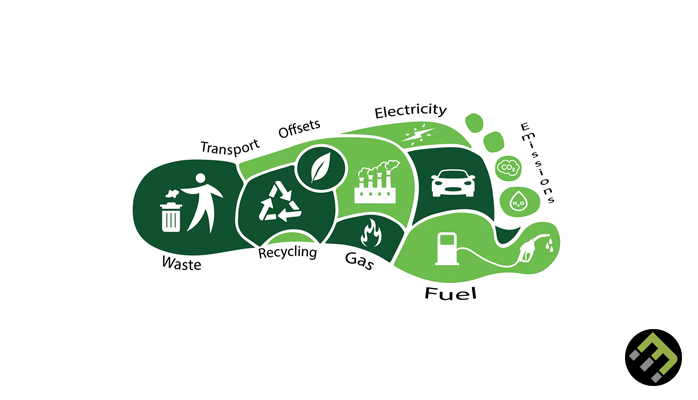Physical Address
304 North Cardinal St.
Dorchester Center, MA 02124

Measuring and monitoring your carbon footprint involves assessing the total amount of greenhouse gases you produce directly and indirectly. It’s vital to adopt practices that contribute to sustainable living.
Understanding your carbon footprint is the first step towards sustainable living. This process entails calculating emissions from activities like travel, energy usage, and consumption habits. Businesses and individuals use this metric to strategize on reducing their environmental impact. Tools like online calculators or environmental consulting services provide insights into where and how emissions occur.
By consistently tracking these emissions, one can set tangible targets for reduction. This not only supports worldwide efforts to combat climate change but also encourages a shift towards more mindful consumption patterns and energy use. Adopting a sustainable lifestyle often results in economic benefits alongside the primary goal of environmental responsibility. Key to this process is regular reassessment and adjustment to stay on track with sustainability goals.

Sustainable living begins when you know your impact on the planet. Your carbon footprint is the total amount of greenhouse gases you produce. It includes every aspect of your daily life. From the electricity you use to the food you eat. By understanding it, you can take steps to live greener.
Every action counts when it comes to carbon footprints:
Let’s see how personal footprints measure against the world. Take a look:
| Region | Average Footprint (tons CO2/year) | Personal Target (tons CO2/year) |
|---|---|---|
| World | 4.8 | < 2.0 |
| USA | 16.5 | < 2.0 |
| Europe | 6.4 | < 2.0 |
Aim for a target lower than two tons of CO2 a year to help the planet.
Knowing your carbon footprint is the first step towards making more sustainable choices. It’s like having a climate change scorecard for your lifestyle. When you understand how your actions impact the planet, you can take control and make changes. Here are some straightforward methods to get you started on measuring and monitoring your carbon footprint.
One of the easiest ways to check your footprint is with online calculators. These tools ask questions about your lifestyle. They cover your home, travel, and eating habits. Below are the simple steps to use them:
Many websites offer these calculators for free. Each one might be a bit different. Try a few to get a well-rounded view of your emissions.
If you’re up for some math, calculating your footprint manually is possible too. Here’s a simple guide on how to do it:
Remember, accuracy is key. Collect all the data you can for the most precise calculation.
Measuring your carbon footprint doesn’t have to be complicated. These simple techniques give you a starting point. Once you know where you stand, you can set goals to reduce your impact and live more sustainably.
Understanding the top contributors to our carbon footprint helps us make smarter choices. Let’s dive into everyday activities that add up. Simple changes can lead to a sustainable lifestyle.
Cars, buses, and planes emit carbon dioxide. These are essential for daily commutes and leisure travel. Opting for public transit, carpooling, and eco-friendly vehicles makes a difference.
Every home has a carbon footprint. This comes from heating, cooling, and powering devices. Energy-efficient appliances and mindful usage reduce emissions.
| Appliance | Action | Impact |
|---|---|---|
| Heating systems | Lower the thermostat | Less energy used |
| Lights | Switch to LEDs | Fewer CO2 emissions |
| Electronics | Unplug when not in use | Energy and money saved |
Your plate has a story of travel and production. Local, plant-based foods are better for the planet. They use less water and energy.
Sustainability begins with awareness and action. Reducing your carbon footprint can seem daunting, but with practical strategies, it becomes manageable. Simple changes in energy consumption, transportation, and waste management make a significant difference. Let’s dive into actionable steps to lessen our environmental impact.
Renewable energy is clean and inexhaustible. Using solar panels or wind turbines cuts emissions and energy bills. Upgrading to energy-efficient appliances also helps. Here’s how to integrate renewable energy:
Transport is a major carbon contributor. Opting for cycling, carpooling, or public transport curbs emissions. Here’s a comparison of green commuting options:
| Mode of Transport | Carbon Savings | Health Benefits |
|---|---|---|
| Cycling | High | Excellent |
| Carpooling | Medium | Good |
| Public Transport | Variable | Good |
Reducing waste and recycling are key to sustainability. Aim to buy less and reuse more. Start recycling by:
Embracing sustainable living involves more than just making a few eco-friendly choices. It requires close monitoring of progress and setting clear, achievable goals. By consistently tracking your carbon footprint, you create a roadmap for ongoing improvements. Understanding your environmental impact is the first step to making meaningful changes. Let’s delve into how to keep an eye on your carbon reduction journey and integrate sustainability into your life’s mission.
Consistency is key when it comes to reducing your carbon footprint. It’s essential to track the changes you implement in your daily life. This can be done through:
Using a carbon footprint calculator can simplify this process. Regularly update your activities and measure the impact. Not only does this help ensure you’re on the right track, but it can also be highly motivating.
While reducing emissions is crucial, some carbon release is inevitable. That’s where carbon offsetting and credits come into play. These are tools that allow for the balancing of one’s carbon footprint by:
A mix of personal reductions and offsets pushes us closer to sustainability goals. Research carefully and choose verified offset providers. These details help ensure that your efforts contribute to real-world environmental benefits.
Leveraging technology proves crucial in the sustainable living movement. In recent years, innovations have emerged to help both individuals and organizations track and reduce their environmental impact. With a sharp focus on carbon footprint, technology offers a suite of tools designed to make sustainable living a practical, accessible reality. Here’s how technology is changing the game:
Several applications and online platforms are now available to help users measure and minimize their carbon emissions. From tracking travel emissions to analyzing household energy use, these apps provide actionable insights into our daily habits.
Smart home devices have revolutionized energy consumption monitoring and management at home. Modern gadgets seamlessly integrate with mobile devices, providing real-time data and control over household energy usage.
| Technology | Benefit |
|---|---|
| Smart Thermostats | Automate heating and cooling for optimal energy use. |
| LED Lighting Systems | Use less energy and last longer than traditional bulbs. |
| Smart Power Strips | Reduce standby power consumption in electronics. |
With these technologies, individuals can greatly reduce their energy consumption, benefiting both their wallets and the planet.

Credit: www.thelancet.com
A carbon footprint is the total amount of greenhouse gases emitted by an individual, organization, event, or product. It’s measured in carbon dioxide equivalents (CO2e) and includes all gases that affect the climate, allowing for easier comparability and monitoring for reduction efforts.
To calculate your personal carbon footprint, use online calculators that consider factors such as energy consumption, travel habits, diet, and waste production. These tools provide an estimate by measuring CO2e emissions based on your lifestyle choices and daily activities.
Monitoring your carbon footprint is essential because it helps identify the most significant sources of emissions in your life. By understanding these, you can make informed decisions to reduce your impact on the environment, contributing to global sustainability and climate change mitigation efforts.
Effective ways to reduce your carbon footprint include using renewable energy sources, choosing energy-efficient appliances, reducing meat consumption, recycling, using public transport, and cutting down on air travel. Small lifestyle changes, when adopted widely, can lead to significant environmental benefits.
Understanding our carbon footprint is vital for sustaining our planet. Regular tracking enables informed choices, fostering a greener lifestyle. Embrace this journey; our collective efforts contribute to a healthier Earth. Remember, small steps can lead to significant change. Let’s act now for a brighter tomorrow.

